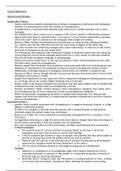Social Explanations
Dysfunctional Families
Double Bind Theory
- Double bind theory explains schizophrenia as being a consequence of abnormal and inadequate
patterns of communication within the families of schizophrenics.
- A double bind is a communication dilemma that comes from a conflict between two or more
messages.
- The double bind’s effect shows up in a collapse of the victim’s ability to differentiate between
logical types and ways of communication, it can occur in a very intense relationship or perhaps
when they aren’t able to comment on the messages other people are sending.
- Bateson (1956): families of schizophrenics communicate in a destructively ambiguous fashion,
e.g. mother with tell the child she loves him but turns away in disgust at the same time.
- The child receives two conflicting messages about their relationship, of affection on the verbal
level and of animosity on the non-verbal level.
- The developing child regularly finds themselves trapped in situations where they fear doing the
wrong thing but receive mixed messages about what this is, they cannot win because whatever
they do will either be against language or paralanguage.
- Double bind theory states that it is the way the parents or other family members interact with
the child which causes the schizophrenia.
- Bateson argued that the double-bind statements could eventually lead to the hallucinations and
delusions of schizophrenia, the symptoms arising as a means of escaping the mental conflict.
- Additionally, prolonged exposure to ambiguous interactions can manifest in symptoms like
flatness of affect, formal thought disorder and paranoia because the patient doesn’t have a fully
developed construction of reality.
- Double bind statements can also cause the child to respond to maladaptive thinking patterns such
as ‘all things said to me contain hidden meanings that are harmful’
- Berger (1965): interviewed schizophrenics and found that they had a higher recall of double-bind
statements by their mothers than non-schizophrenic controls.
- Mischler and Waxler (1968): mothers talking to their schizophrenic daughters were rather aloof
and unresponsive but far more responsive to their non-schizophrenic daughters.
- While not specifically investigating the effect of double-bind statements, this does provide
support that there are differences in communications between schizophrenics and their families
and non-schizophrenics.
Expressed Emotion
- Another family variable associated with schizophrenia is a negative emotional climate, or a high
degree of expressed emotion.
- EE refers to a caregiver’s attitude towards a person with a mental disorder as reflected by
comments about the patient made to an interviewer.
- Brown et al (1958): EE is more important in maintaining schizophrenia that in causing it in the
first place.
- Schizophrenics returning to a high EE family were more likely to relapse than those returning to a
low EE family, particularly if this was coupled with no medication.
- The main components of EE are Critical Comments, Hostility and Emotional Over Involvement.
- Critical Comments
The quantification of critical comments is greatly reliant on the way in which the
respondent uses their tone of voice to convey their feelings.
Critical caregivers get involved in angry exchanges with patients and they seem unable to
prevent or to step away from the patient which can lead to violence.
Patients who can’t get up in the morning may be accused of being lazy by EE caregivers,
while low EE caregivers would attribute behaviours to the illness.
70% of critical comments focused on the negative symptoms of schizophrenia.
- Hostility
Hostility is a consequence of unmanageable anger and irritation followed by critical
comments and leads to rejection of the patient. It is expressed by general criticisms or
attitudes that are rejecting the patient.
Amaresha (2012): caregivers state that the patient is causing problems for them, wishing
to live away from the patient, shouting at them, claiming the patient is just acting.





